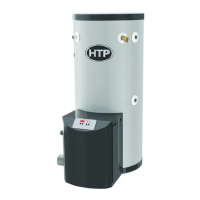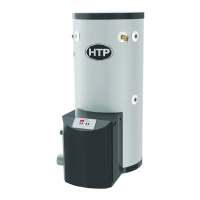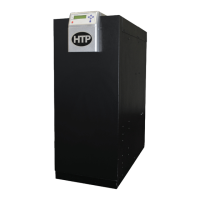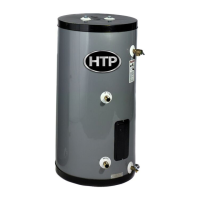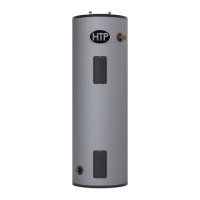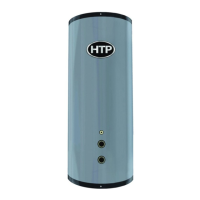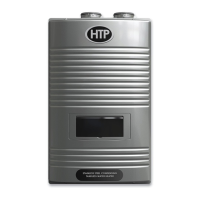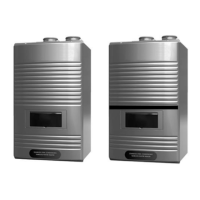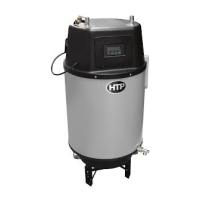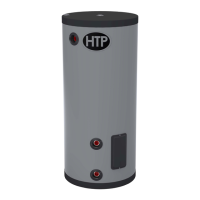LP-454 Rev. 004 Rel. 002 Date 12.1.17
11
venting system. Turn on any exhaust fans, such as range hoods and
bathroom exhausts, at maximum speed. Do not operate a summer
exhaust fan. Close all replace dampers.
4. Place in operation the appliance being inspected. Follow the
lighting instructions. Adjust the thermostat so the appliance will
operate continuously.
5. Test for spillage at the draft hood relief opening after 5 minutes of
main burner operation. Use the ame of a match or candle or smoke
from a cigarette.
6. After it has been determined that each appliance remaining
connected to the common venting system properly vents when
tested as outlined, return doors, windows, exhaust fans, replace
dampers, and any other gas burning appliances to their previous
condition of use.
7. Any improper operation of the common venting system should
be corrected to conform to the National Fuel Gas Code, ANSI Z223.1.
When resizing any portion of the common venting system, the
system should approach the minimum size as determined using the
appropriate tables in Appendix G of ANSI Z223.1.
I. Water Chemistry Requirements
Chemical imbalance of the water supply may aect eciency and
cause severe damage to the appliance and associated equipment.
Water quality must be professionally analyzed to determine
whether it is necessary to treat the water. Various solutions are
available to adjust water quality. Adverse water quality will aect
the reliability of the system. In addition, operating temperatures
above 135
o
F will accelerate the build-up of lime scale and possibly
shorten appliance service life. Failure of an appliance due to
lime scale build-up, low pH, or other chemical imbalance IS NOT
covered by the warranty.
The water must be potable, free of corrosive chemicals, sand,
dirt, and other contaminates. It is up to the installer to ensure the
water does not contain corrosive chemicals or elements that can
damage the heat exchanger. Potable water is dened as drinkable
water supplied from utility or well water in compliance with EPA
secondary maximum contaminant levels (40 CFR Part 143.3). If
the water contains contaminants higher than outlined by the EPA,
water treatment is recommended and additional, more frequent
maintenance may be required.
If you suspect that your water is contaminated in any way,
discontinue use of the appliance and contact an authorized
technician or licensed professional.
• Water pH between 6.5 and 8.5
• pH levels below 6.5 can cause an increase in the rate of
corrosion. pH of 8.5 or higher can potentially cause lime
scale build-up
• Maintain water pH between 6.5 and 8.5. Check with litmus
paper or have it chemically analyzed by a local water
treatment company.
• If the pH is not between 6.5 and 8.5, consult a local water
treatment company for solutions.
• Hardness less than 7 grains (120 mg/L) (Commercial Use
- water temperatures of 140
o
F and greater)
• Hardness levels above the required amounts can lead to
lime scale build-up throughout the system. Water below 5
grains/gallon (85 mg/L) may be over softened.
• Consult local water treatment companies for unusually
hard water areas (above the required amounts) or for
other treatment solutions if water is being over softened
(below 5 grains/gallon [85 mg/L]).
• Chloride concentration less than 100 ppm (mg/L)
• Do not ll appliance or operate with water containing
chlorides in excess of 100 ppm (mg/L).
• Using chlorinated fresh water should be acceptable as levels
are typically less than 5 ppm (mg/L).
• Do not connect the appliance to directly heat swimming
pool or spa water.
• Total Dissolved Solids (TDS) less than 500 ppm (mg/L)
• Total dissolved solids are minerals, salts, metals, and charged
particles that are dissolved in water.
• The greater the amounts of TDS present, the higher the
corrosion potential due to increased conductivity in the
water.
• If using softened water to ll the appliance, it is still possible
to have high TDS. This water can be corrosive. Consult local
water treatment companies for other treatment solutions to
reduce this eect.
*NOTE: To promote appliance service life, it is strongly recommended
to follow the maintenance procedures in this manual.
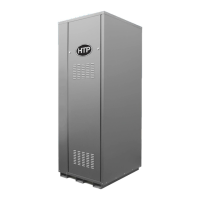
